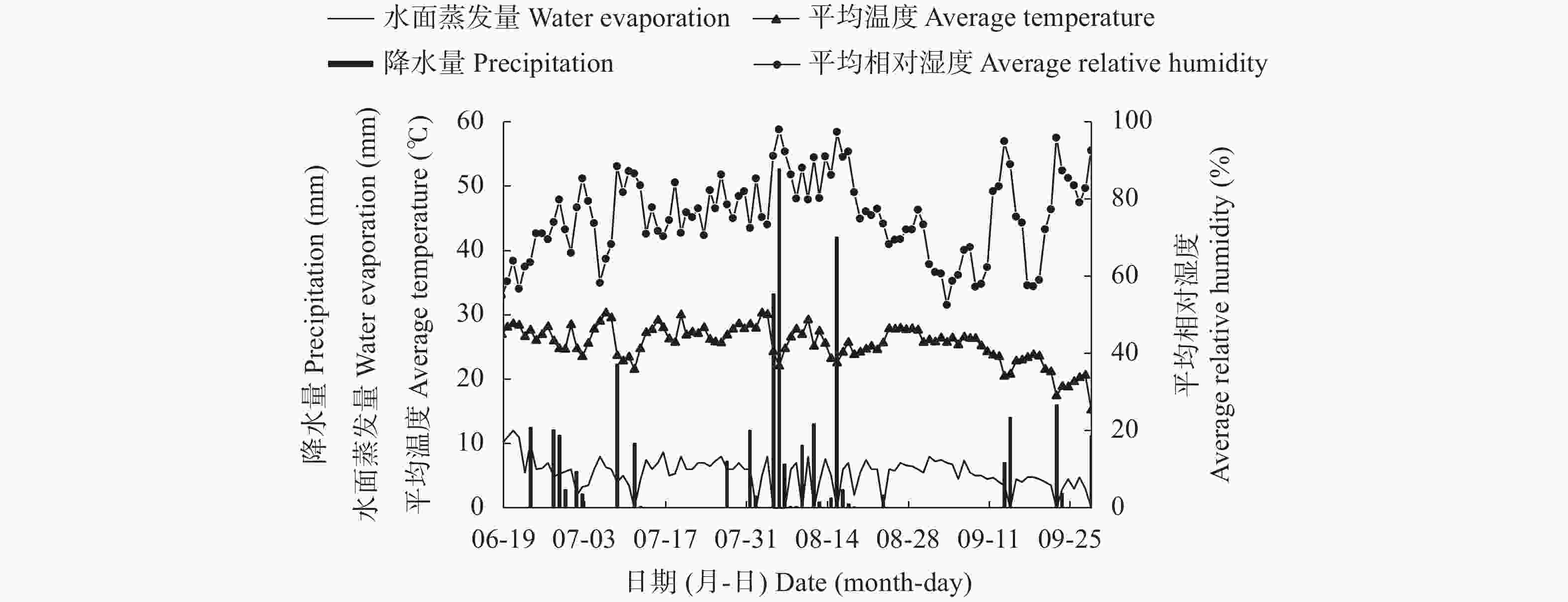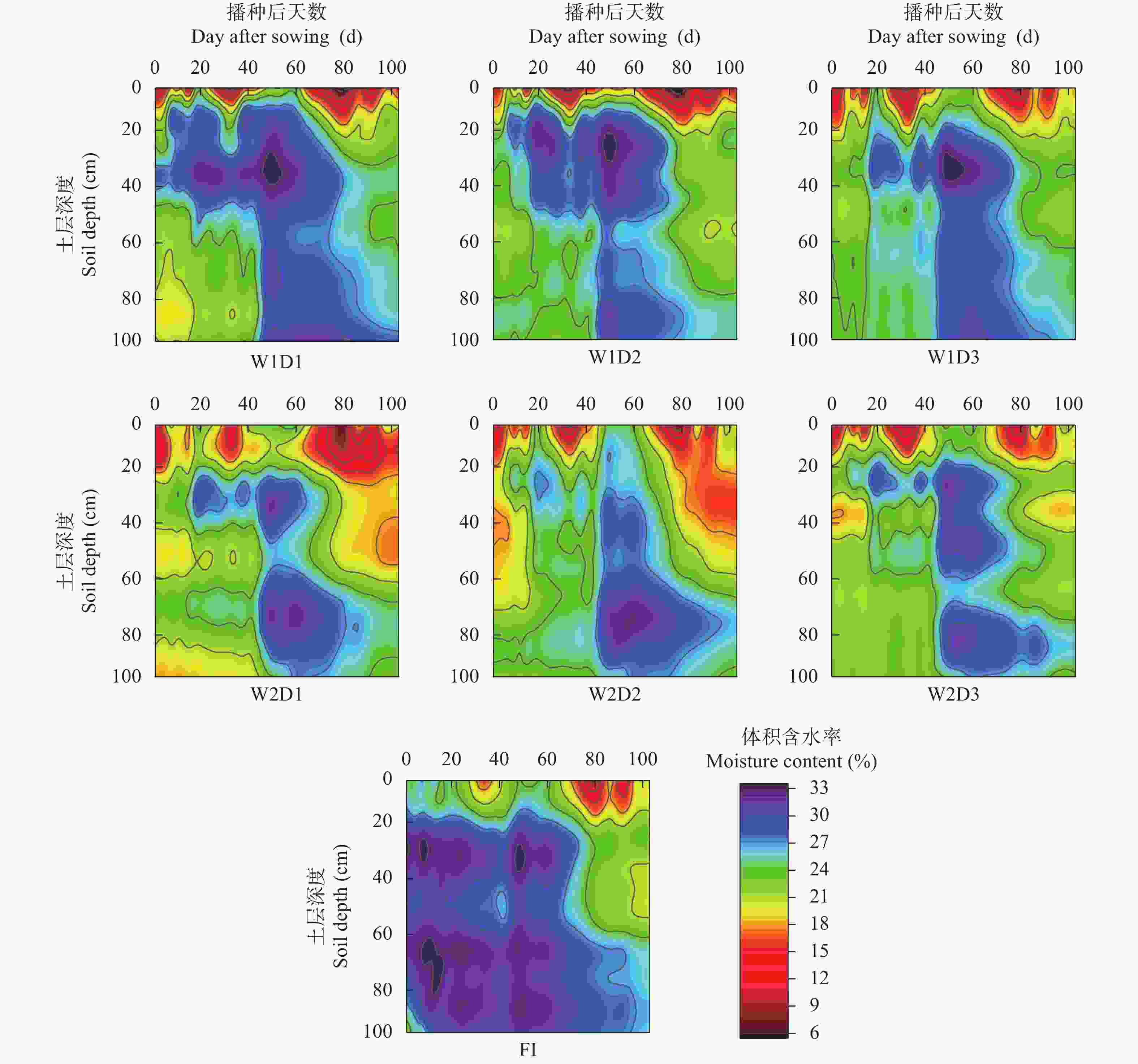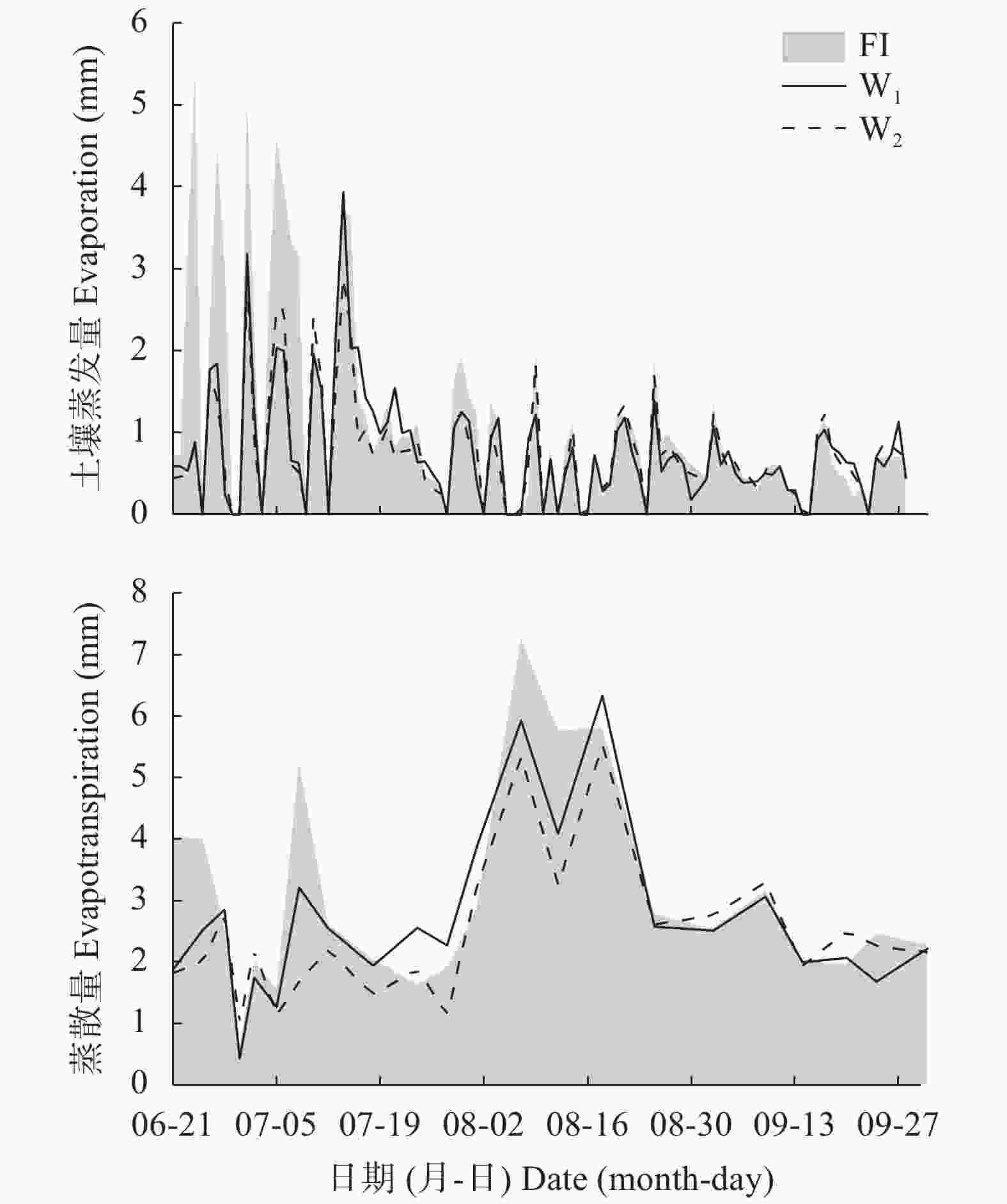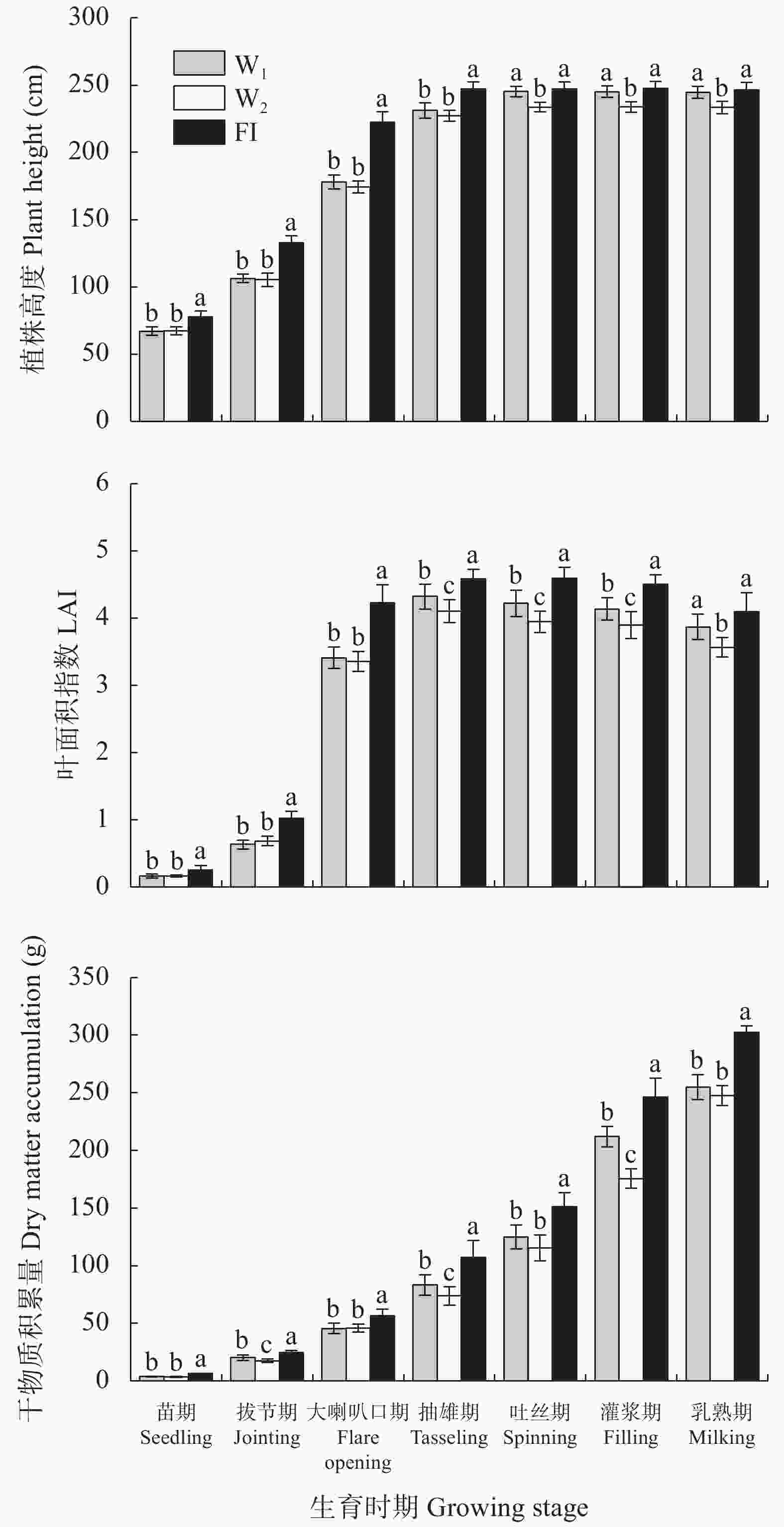齐永青1,
李怀辉3,
沈彦俊1,,
1.中国科学院遗传与发育生物学研究所农业资源研究中心/中国科学院农业水资源重点实验室/河北省节水农业重点实验室 石家庄 050022
2.中国科学院大学 北京 100049
3.甘肃农业大学水利水电工程学院 兰州 730070
基金项目:河北省重点研发计划国际科技合作专项(18397002D)、中国科学院国际伙伴计划(153E13KYSB20170010)、国家重点研发计划课题(2016YFC0401403)和国家自然科学基金面上项目(41877169)资助
详细信息
作者简介:要家威,主要研究方向为节水农业与灌溉技术。E-mail: yjwzh13@163.com
通讯作者:沈彦俊,主要研究方向为农业水文与水资源、节水农业。E-mail: yjshen@sjziam.ac.cn
中图分类号:S275.6计量
文章访问数:62
HTML全文浏览量:19
PDF下载量:35
被引次数:0
出版历程
收稿日期:2021-01-28
录用日期:2021-03-26
网络出版日期:2021-07-13
刊出日期:2021-09-06
Effects of the irrigation quota and drip irrigation pipes spacing on growth and development of summer maize with subsurface drip irrigation
YAO Jiawei1, 2,,QI Yongqing1,
LI Huaihui3,
SHEN Yanjun1,,
1. Center for Agricultural Resources Research, Institute of Genetics and Developmental Biology, Chinese Academy of Sciences / Key Laboratory of Agricultural Water Resources, Chinese Academy of Sciences / Hebei Laboratory of Water-Saving Agriculture, Shijiazhuang 050022, China
2. University of Chinese Academy of Sciences, Beijing 100049, China
3. College of Water Conservancy and Hydropower Engineering, Gansu Agricultural University, Lanzhou 730070, China
Funds:This study was supported by the Program of Key Research and Development Plan and International Science and Technology Cooperation in Hebei Province (18397002D), the International Partners Program of Chinese Academy of Sciences (153E13KYSB20170010), the National Key Research and Development Project of China (2016YFC0401403), and the National Natural Science Foundation of China (41877169)
More Information
Corresponding author:E-mail: yjshen@sjziam.ac.cn
摘要
HTML全文
图
参考文献
相关文章
施引文献
资源附件
访问统计
摘要
摘要:为探究地下滴灌条件下不同灌溉量与滴灌带间距对夏玉米生长发育与耗水特征的影响, 查明地下滴灌对田间尺度水平衡的影响特征, 基于2种灌溉定额(62 mm和35 mm)与3种滴灌带间距(60 cm、80 cm和100 cm)的田间试验, 并以华北典型农田地面灌溉方式为对照, 分析不同处理对夏玉米生长发育、土壤剖面水分分布、蒸散量及土壤蒸发的影响。结果表明: 地下滴灌处理灌溉水主要停留于20~60 cm土层, 灌溉量越高, 湿润范围越大; 相对地面灌溉处理, 地下滴灌处理地表0~20 cm与60~100 cm土壤含水量相对较低。玉米株高、叶面积指数与干物质积累量随地下滴灌灌溉量的增加而增加, 地面灌溉处理可促进株高与干物质积累, 地下滴灌低灌溉量导致玉米生育进程延迟。与地面灌溉处理相比, 地下滴灌处理可在减少22%的灌溉量的条件下保证作物产量无显著下降, 土壤蒸发相对降低30%, 蒸散量相对降低8%, E/ET值由0.34降低至0.27, 灌溉水利用效率提高20%, 收获指数增加10%。不同滴灌带间距处理对玉米生长发育及耗水特征无显著影响。综合夏玉米生长、产量、灌溉水利用效率和滴灌设备投资成本, 本试验条件下最优设计方案为灌溉量为62 mm, 滴灌带间距为100 cm。
关键词:夏玉米/
地下滴灌/
土壤蒸发/
土壤水分/
水分利用效率
Abstract:Water and soil resources in the North China Plain are mismatched. Traditional flood irrigation methods in this area have low water resource utilization and lead to serious water loss, which has caused a rapid decrease in groundwater levels. This study aims to improve the efficiency of irrigation water use in this area, determine the influence of subsurface drip irrigation on the field-scale water balance, and explore the effects of different irrigation amounts and drip irrigation zone spacing on the growth and water consumption of summer maize under subsurface drip irrigation conditions. Field experiments with two irrigation quotas (62 and 35 mm) and three drip irrigation pipes spacings (60, 80, and 100 cm) were conducted with the conventional flood irrigation as the control in farmlands in the North China Plain to analyze their effects on the growth and development, yield and irrigation water use efficiency of summer maize, and the soil profile moisture distribution, evapotranspiration, evaporation. Soil evaporation under subsurface drip irrigation was measured and compared using a microlysimeter. The results showed that irrigation water from subsurface drip irrigation mainly stayed in the 20–60 cm soil layer, and the wetted body presented a “small up and large down” form. The higher the irrigation amount, the larger the wetted body range, and the larger the soil volumetric water content. Compared to flood irrigation, the soil moisture contents of the 0–20 cm and 60–100 cm soil layers from subsurface drip irrigation were relatively low, and a dry soil layer formed at about 0–10 cm layer, which reduced soil evaporation. Maize plant height, leaf area index, and dry matter accumulation increased with increasing amounts of subsurface drip irrigation. Under flood irrigation, the maize plant height increased faster, and the accumulation rate of the maximum dry matter was higher compared to subsurface drip irrigation. Low amounts of subsurface drip irrigation delayed maize growth. When the irrigation amount was reduced by 22%, maize yield under subsurface drip irrigation did not differ from maize yield under traditional flood irrigation. Compared to flood irrigation, subsurface drip irrigation reduced soil evaporation by 30%, evapotranspiration by 8%, the E/ET value from 0.34 to 0.27; and increased the irrigation water use efficiency by 20%, the harvest index by 10%. The different drip irrigation zone spacing treatments had no effect on the growth and water consumption of maize. For high maize growth and yield, efficient irrigation water use, and cost-effective investments in drip irrigation equipment, the optimal irrigation quota was 62 mm with a drip irrigation zone spacing of 100 cm.
Key words:Summer maize/
Subsurface drip irrigation/
Soil evaporation/
Soil moisture/
Water use efficiency
HTML全文

图1试验地试验期内降雨量、水面蒸发量、平均温度与平均相对湿度
Figure1.Rainfall, water evaporation, average temperature and average relative humidity during the test period in the experiment site
 下载: 全尺寸图片幻灯片
下载: 全尺寸图片幻灯片
图2玉米生育期内不同处理0~100 cm土壤体积含水量随时间变化过程
W1为62 mm的灌溉量处理, W2为35 mm的灌溉量处理, D1为60 cm的滴灌带间距处理, D2为80 cm的滴灌带间距处理, D3为100 cm的滴灌带间距处理, FI为地面灌溉80 mm处理。W1 and W2 indicate irrigation volumes of 62 mm and 35 mm, respectively; D1, D2 and D3 indicate drip tapes spacing of 60 cm, 80 cm and 100 cm, respectively. FI indicates flood irrigation with 80 mm volume.
Figure2.Variation process of 0?100 cm soil volumetric water contents with different treatments during the growth period of maize
 下载: 全尺寸图片幻灯片
下载: 全尺寸图片幻灯片
图3不同处理下夏玉米生育期内日土壤蒸发量和日蒸散量
W1为62 mm的灌溉量处理, W2为35 mm的灌溉量处理, FI为地面灌溉80 mm处理。W1 and W2 indicate irrigation volumes of 62 mm and 35 mm, respectively. FI indicates flood irrigation with 80 mm volume.
Figure3.Daily evaporation and evapotranspiration during the growth period of summer corn under different treatments
 下载: 全尺寸图片幻灯片
下载: 全尺寸图片幻灯片
图4不同处理下夏玉米不同生育期株高、叶面积指数和干物质量
W1为62 mm的灌溉量处理, W2为35 mm的灌溉量处理, FI代表地面灌溉80 mm处理。不同小写字母表示同一生育期不同处理间差异显著(P<0.05)。W1 and W2 indicate irrigation volumes of 62 mm and 35 mm, respectively. FI indicates flood irrigation with 80 mm volume. Different lowercase letters mean significant differences at P<0.05 level among different treatments at the same growing stage.
Figure4.Plant height, leaf area index and dry matter quality of summer corn at different growth stages under different treatments
 下载: 全尺寸图片幻灯片
下载: 全尺寸图片幻灯片表1试验处理设计方案
Table1.Design scheme of test treatments
| 处理 Treatment | 滴灌带间距 Pipes spacing (cm) | 不同日期(月-日)的灌溉定额 Irrigation quotas in different dates (month-day) (mm) | 灌溉总量 Total irrigation (mm) | 灌溉方式 Irrigation methods | ||
| 06-22 | 07-07 | 07-27 | ||||
| W1D1 | 60 | 15 | 17 | 30 | 62 | 地下滴灌 Subsurface drip irrigation |
| W1D2 | 80 | 15 | 17 | 30 | 62 | 地下滴灌 Subsurface drip irrigation |
| W1D3 | 100 | 15 | 17 | 30 | 62 | 地下滴灌 Subsurface drip irrigation |
| W2D1 | 60 | 15 | 10 | 10 | 35 | 地下滴灌 Subsurface drip irrigation |
| W2D2 | 80 | 15 | 10 | 10 | 35 | 地下滴灌 Subsurface drip irrigation |
| W2D3 | 100 | 15 | 10 | 10 | 35 | 地下滴灌 Subsurface drip irrigation |
| FI | 80 | 80 | 地面灌溉 Flooding irrigation | |||
 下载: 导出CSV
下载: 导出CSV表2不同处理下夏玉米蒸散量、土壤蒸发量与作物蒸腾量
Table2.Summer corn evapotranspiration, evaporation and transpiration under different treatments
| 处理 Treatment | 土壤储水量 Soil water storage (ΔS, mm) | 蒸散量 Evapotranspiration (ET, mm) | 棵间蒸发 Evaporation (E, mm) | 作物蒸腾 Transpiration (T, mm) | E/ET | |
| W1 | D1 | 28.89±4.27a | 293.90±4.27a | 75.62±2.66b | 218.28±4.07a | 0.26±0.01b |
| D2 | 23.11±4.96a | 299.68±4.96a | 82.46±1.33a | 217.22±5.96a | 0.28±0.01a | |
| D3 | 22.92±15.96a | 299.87±15.96a | 76.53±2.46b | 223.34±13.62a | 0.26±0.01b | |
| W2 | D1 | 20.83±14.14a | 274.96±14.14a | 75.997.35a | 198.97±15.59a | 0.28±0.03a |
| D2 | 22.85±12.29a | 272.94±12.29a | 74.43±5.30a | 198.51±17.34a | 0.27±0.03a | |
| D3 | 25.94±9.26a | 269.85±9.26a | 73.69±10.04a | 196.16±11.38a | 0.27±0.04a | |
| W1 | 24.97±9.11A | 297.81±9.11B | 78.20±3.75B | 219.61±8.21A | 0.26±0.01B | |
| W2 | 23.21±10.68A | 272.58±10.68C | 74.70±6.84B | 197.87±13.04B | 0.27±0.03B | |
| FI | 8.57±5.67B | 324.22±5.67A | 109.34±4.65A | 214.87±1.02A | 0.34±0.01A | |
| W | NS | ** | NS | ** | NS | |
| D | NS | NS | NS | NS | NS | |
| W×D | NS | NS | NS | NS | NS | |
| W1为62 mm的灌溉量处理, W2为35 mm的灌溉量处理, D1为60 cm的滴灌带间距处理, D2为80 cm的滴灌带间距处理, D3为100 cm的滴灌带间距处理, W代表不同灌溉量处理, D代表不同滴灌带间距处理, FI代表地面灌溉(灌溉量为80 mm)。同列同一灌溉量水平下不同小写字母表示不同滴灌带间距间差异显著(P<0.05), 同列不同大写字母表示地下滴灌不同灌水量及地面灌溉间差异显著(P<0.05)。NS表示无显著影响, *和**分别表示在P<0.05和P<0.01水平影响显著。W1 and W2 indicate irrigation volumes of 62 mm and 35 mm, respectively; D1, D2 and D3 indicate drip tapes spacing of 60 cm, 80 cm and 100 cm, respectively. FI indicates flood irrigation with 80 mm volume. Different lowercase letters in the same column for the same irrigation level mean significant differences at P<0.05 level among different drip taps spacing treatments. Different capital letters mean significant differences at P<0.05 level among subsurface drip irrigation quotas and flood irrigation. NS means no significant effect, * and ** indicate significant effect at P<0.05 and P<0.01, respectively. | ||||||
 下载: 导出CSV
下载: 导出CSV表3不同处理下夏玉米不同生育期株高、叶面积指数和干物质量显著性分析表
Table3.Significance analysis of plant height, leaf area index and dry matter quality of summer maize at different growth stages under different treatments
| 处理 Treatment | 苗期 Seedling | 拔节期 Jointing | 大喇叭口期 Flare opening | 抽雄期 Tasseling | 吐丝期 Spinning | 灌浆期 Filling | 乳熟期 Milking | |
| 株高 Plant height | W | NS | NS | NS | NS | ** | ** | ** |
| D | NS | NS | NS | NS | NS | NS | NS | |
| W×D | NS | NS | NS | NS | NS | NS | NS | |
| 叶面积指数 Leaf area index | W | NS | NS | NS | ** | ** | ** | ** |
| D | NS | NS | NS | NS | NS | NS | NS | |
| W×D | NS | NS | NS | NS | NS | NS | NS | |
| 干物质积累量 Dry matter accumulation | W | NS | ** | NS | NS | NS | ** | NS |
| D | NS | NS | NS | NS | NS | NS | NS | |
| W×D | NS | NS | NS | NS | NS | NS | NS | |
| W为灌溉量处理, D为滴灌带间距处理, NS表示处理间无显著影响, *和**分别表示在P<0.05和P<0.01水平影响显著。W indicates irrigation treatments; D indicates drip tapes spacing treatments. NS means no significant effect; * and ** indicate significant effect at P<0.05 and P<0.01 levels, respectively. | ||||||||
 下载: 导出CSV
下载: 导出CSV表4不同处理下夏玉米干物质积累的Logistic模拟特征值
Table4.Logistic simulation eigenvalues value of dry matter accumulation of summer maize under different treatments
| 处理 Treatment | 方程 Equation | Vm (g?d?1) | Tm (d) | T1 (d) | T2 (d) | ΔT (d) | R2 |
| W1D1 | y=336.24/[1+exp(5.50?0.075T)] | 6.3 | 73.7 | 56.0 | 91.3 | 35.3 | 0.995 |
| W1D2 | y=322.52/[1+exp(5.84?0.081T)] | 6.5 | 72.5 | 56.1 | 88.8 | 32.7 | 0.997 |
| W1D3 | y=332.48/[1+exp(5.74?0.079T)] | 6.6 | 72.3 | 55.7 | 88.9 | 33.2 | 0.997 |
| W2D1 | y=440.83/[1+exp(5.16?0.060T)] | 6.6 | 85.5 | 63.7 | 107.4 | 43.7 | 0.997 |
| W2D2 | y=403.55/[1+exp(5.27?0.064T)] | 6.5 | 82.1 | 61.6 | 102.6 | 41.0 | 0.998 |
| W2D3 | y=456.40/[1+exp(5.26?0.061T)] | 7.0 | 86.1 | 64.5 | 107.7 | 43.2 | 0.998 |
| FI | y=401.83/[1+exp(5.36?0.073T)] | 7.3 | 73.5 | 55.4 | 91.5 | 36.1 | 0.997 |
| W1为62 mm的灌溉量处理, W2为35 mm的灌溉量处理, D1为60 cm的滴灌带间距处理, D2为80 cm的滴灌带间距处理, D3为100 cm的滴灌带间距处理, FI为地面灌溉80 mm处理。y表示夏玉米干物质积累量; T表示夏玉米播种后天数; Vm表示干物质最大相对生长速率; Tm表示干物质最大速率出现的时间; T1和T2分别为Logistic曲线的2个拐点; ΔT表示干物质快速积累持续天数。W1 and W2 indicate irrigation volumes of 62 mm and 35 mm, respectively; D1, D2 and D3 indicate drip tapes spacing of 60 cm, 80 cm and 100 cm, respectively. FI indicates flood irrigation with 80 mm volume. y is dry matter accumulation; T is days after sowing; Vm is the maximum growth rate of dry matter, Tm is the time to the maximum rate of dry matter; T1 and T2 are the two inflection points of Logistic function; ΔT is the days of period of rapid accumulation of dry matter. | |||||||
 下载: 导出CSV
下载: 导出CSV表5不同处理下夏玉米产量及水分利用效率
Table5.Summer maize yield and water use efficiency under different treatments
| 处理 Treatment | 穗数 Spike number (104?hm?2) | 穗行数 Number of spike rows | 行粒数 Spikes number | 百粒重 100-seed weight (g) | 产量 Yield (kg?hm?2) | 水分利用效率 Water use efficiency (kg?m?3) | 灌溉水利用效率 Irrigation water use efficiency (kg?m?3) | 收获指数 Harvest index | |
| W1 | D1 | 6 | 14.2±0.8a | 39.47±1.08a | 26.93±2.73a | 8930±342a | 3.04±0.08a | 14.40±0.55a | 0.531±0.020a |
| D2 | 6 | 13.5±0.8a | 36.67±4.16a | 29.03±1.91a | 8885±79a | 2.97±0.05a | 14.33±0.13a | 0.528±0.007a | |
| D3 | 6 | 13.8±1.0a | 38.34±1.46a | 28.12±2.91a | 9112±490a | 3.05±0.32a | 14.70±0.79a | 0.526±0.038a | |
| W2 | D1 | 6 | 14.4±0.8a | 35.80±0.17a | 28.33±2.82a | 8024±544a | 2.93±0.34a | 22.93±1.55a | 0.491±0.051a |
| D2 | 6 | 13.7±1.4a | 34.76±0.40a | 26.56±3.72a | 8170±329a | 3.00±0.02a | 23.34±0.94a | 0.497±0.029a | |
| D3 | 6 | 14.4±1.7a | 35.20±1.68a | 27.13±1.12a | 8320±461a | 3.08±0.07a | 23.77±1.32a | 0.499±0.006a | |
| W1 | 6 | 13.9±0.8A | 38.15±2.57A | 28.03±2.39B | 8976±318A | 3.02±0.17A | 14.47±0.51B | 0.529±0.022A | |
| W2 | 6 | 14.2±1.2A | 35.26±1.03B | 27.05±2.43B | 8171±413B | 3.00±0.19A | 23.35±1.18A | 0.496±0.030B | |
| FI | 6 | 13.7±0.4A | 39.00±1.76A | 32.69±2.16A | 9642±266A | 2.97±0.09A | 12.05±0.33C | 0.478±0.005B | |
| W | NS | ** | NS | ** | NS | ** | ** | ||
| D | NS | NS | NS | NS | NS | NS | NS | ||
| W×D | NS | NS | NS | NS | NS | NS | NS | ||
| W1为62 mm的灌溉量处理, W2为35 mm的灌溉量处理, D1为60 cm的滴灌带间距处理, D2为80 cm的滴灌带间距处理, D3为100 cm的滴灌带间距处理, FI为地面灌溉80 mm处理。W1 and W2 indicate irrigation volumes of 62 mm and 35 mm, respectively; D1, D2 and D3 indicate drip tapes spacing of 60 cm, 80 cm and 100 cm, respectively. FI indicates flood irrigation with 80 mm volume. | |||||||||
 下载: 导出CSV
下载: 导出CSV参考文献
| [1] | 黄峰, 杜太生, 王素芬, 等. 华北地区农业水资源现状和未来保障研究[J]. 中国工程科学, 2019, 21(5): 28?37 HUANG F, DU T S, WANG S F, et al. Current situation and future security of agricultural water resources in North China[J]. Strategic Study of CAE, 2019, 21(5): 28?37 |
| [2] | 刘美英, 闵雷雷, 沈彦俊. 河北平原浅层地下水位动态变化分析[J]. 中国农村水利水电, 2017, (8): 80?85 doi: 10.3969/j.issn.1007-2284.2017.08.018 LIU M Y, MIN L L, SHEN Y J. An analysis of the dynamic variations of shallow groundwater level in the Hebei Plains[J]. China Rural Water and Hydropower, 2017, (8): 80?85 doi: 10.3969/j.issn.1007-2284.2017.08.018 |
| [3] | 张永强, 刘昌明, 沈彦俊. 太行山山前平原浅层地下水位动态分析?以河北省栾城县为例[J]. 中国生态农业学报, 2001, 9(2): 42?44 ZHANG Y Q, LIU C M, SHEN Y J. Analysis of the groundwater level change in Taihang Piedmont — A case study from Luancheng County[J]. Chinese Journal of Eco-Agriculture, 2001, 9(2): 42?44 |
| [4] | 康绍忠. 水安全与粮食安全[J]. 中国生态农业学报, 2014, 22(8): 880?885 KANG S Z. Towards water and food security in China[J]. Chinese Journal of Eco-Agriculture, 2014, 22(8): 880?885 |
| [5] | 程先军, 许迪, 张昊. 地下滴灌技术发展及应用现状综述[J]. 节水灌溉, 1999, (4): 13?15, 42 doi: 10.3969/j.issn.1007-4929.1999.04.005 CHENG X J, XU D, ZHANG H. A summary of development and application situations for subsurface drip irrigation technique[J]. Water Saving Irrigation, 1999, (4): 13?15, 42 doi: 10.3969/j.issn.1007-4929.1999.04.005 |
| [6] | MESHKAT M, WARNER R C, WORKMAN S R. Evaporation reduction potential in an undisturbed soil irrigated with surface drip and sand tube irrigation[J]. Transactions of the ASAE, 2000, 43(1): 79?86 doi: 10.13031/2013.2690 |
| [7] | BORDOVSKY J, LYLE W M, SEGARRA E. Economic evaluation of texas high plains cotton irrigated by lepa and subsurface drip[J]. Texas Journal of Agricultural and Natural Resources, 2000, 13: 67?73 |
| [8] | MARTíNEZ-GIMENO M A, BONET L, PROVENZANO G, et al. Assessment of yield and water productivity of clementine trees under surface and subsurface drip irrigation[J]. Agricultural Water Management, 2018, 206: 209?216 doi: 10.1016/j.agwat.2018.05.011 |
| [9] | MUHAMMAD U, TABASSUM H, JIANG H B, et al. Water-saving potential of subsurface drip irrigation for winter wheat[J]. Sustainability, 2019, 11(10): 2978 doi: 10.3390/su11102978 |
| [10] | AYARS J E, FULTON A, TAYLOR B. Subsurface drip irrigation in California — Here to stay?[J]. Agricultural Water Management, 2015, 157: 39?47 doi: 10.1016/j.agwat.2015.01.001 |
| [11] | 张和喜, 袁友波, 舒贤坤, 等. 地下滴灌条件下土壤水分运动研究[J]. 安徽农业科学, 2008, 36(8): 3277?3279 doi: 10.3969/j.issn.0517-6611.2008.08.111 ZHANG H X, YUAN Y B, SHU X K, et al. Experimental study on soil-water movement under subsurface drip irrigation[J]. Journal of Anhui Agricultural Sciences, 2008, 36(8): 3277?3279 doi: 10.3969/j.issn.0517-6611.2008.08.111 |
| [12] | VALENTíN F, NORTES P A, DOMíNGUEZ A, et al. Comparing evapotranspiration and yield performance of maize under sprinkler, superficial and subsurface drip irrigation in a semi-arid environment[J]. Irrigation Science, 2020, 38(1): 105?115 doi: 10.1007/s00271-019-00657-z |
| [13] | 孙章浩, 黄令淼, 杨培岭, 等. 地下滴灌灌水下限与灌水器流量对冬小麦生长发育的影响[J]. 中国农业大学学报, 2019, 24(11): 41?50 doi: 10.11841/j.issn.1007-4333.2019.11.05 SUN Z H, HUANG L M, YANG P L, et al. Effect of lower irrigation limit and emitter flow on winter wheat growth under subsurface drip irrigation[J]. Journal of China Agricultural University, 2019, 24(11): 41?50 doi: 10.11841/j.issn.1007-4333.2019.11.05 |
| [14] | CALDWELL D S, SPURGEON W E, MANGES H L. Frequency of irrigation for subsurface drip-irrigated corn[J]. Transactions of the ASAE, 1994, 37(4): 1099?1103 doi: 10.13031/2013.28181 |
| [15] | 廉喜旺. 阿勒泰地区地下滴灌条件下苜蓿滴灌带布设方式及高效用水研究[D]. 呼和浩特: 内蒙古农业大学, 2014 LIAN X W. Study on water efficiency and the laying of drip tape under the condition of underground drip irrigation of alfalfa in the areas of Altay[D]. Hohhot: Inner Mongolia Agricultural University, 2014 |
| [16] | SIDHU H S, JAT M L, SINGH Y, et al. Sub-surface drip fertigation with conservation agriculture in a rice-wheat system: a breakthrough for addressing water and nitrogen use efficiency[J]. Agricultural Water Management, 2019, 216: 273?283 doi: 10.1016/j.agwat.2019.02.019 |
| [17] | ENCISO J, JIFON J, WIEDENFELD B. Subsurface drip irrigation of Onions: Effects of drip tape emitter spacing on yield and quality[J]. Agricultural Water Management, 2007, 92(3): 126?130 doi: 10.1016/j.agwat.2007.05.017 |
| [18] | 李兴强, 孙兆军, 曾玉霞, 等. 地下渗灌不同埋深对大田茄子产量和水分利用效率的影响[J]. 节水灌溉, 2020, (5): 27?31 doi: 10.3969/j.issn.1007-4929.2020.05.006 LI X Q, SUN Z J, ZENG Y X, et al. Effects of different buried depths on yield and water use efficiency of eggplant under underground infiltration irrigation condition[J]. Water Saving Irrigation, 2020, (5): 27?31 doi: 10.3969/j.issn.1007-4929.2020.05.006 |
| [19] | GRABOW G L, HUFFMAN R L, EVANS R O, et al. Water distribution from a subsurface drip irrigation system and dripline spacing effect on cotton yield and water use efficiency in a coastal plain soil[J]. Transactions of the ASABE, 2006, 49(6): 1823?1835 doi: 10.13031/2013.22303 |
| [20] | CAMP C R, BAUER P J, HUNT P G. Subsurface drip irrigation lateral spacing and management for cotton in the southeastern coastal plain[J]. Transactions of the ASAE, 1997, 40(4): 993?999 doi: 10.13031/2013.21351 |
| [21] | SUN H Y, LIU C M, ZHANG X Y, et al. Effects of irrigation on water balance, yield and WUE of winter wheat in the North China Plain[J]. Agricultural Water Management, 2006, 85(1/2): 211?218 |
| [22] | 雷钧杰, 张永强, 赛力汗·赛, 等. 施氮量对滴灌冬小麦干物质积累、分配与转运的影响[J]. 麦类作物学报, 2017, 37(8): 1078?1086 doi: 10.7606/j.issn.1009-1041.2017.08.11 LEI J J, ZHANG Y Q, S·SAI, et al. Effect of nitrogen application rate on dry matter accumulation, distribution and translocation of winter wheat under drip irrigation[J]. Journal of Triticeae Crops, 2017, 37(8): 1078?1086 doi: 10.7606/j.issn.1009-1041.2017.08.11 |
| [23] | 谢光辉, 韩东倩, 王晓玉, 等. 中国禾谷类大田作物收获指数和秸秆系数[J]. 中国农业大学学报, 2011, 16(1): 1?8 doi: 10.11841/j.issn.1007-4333.2011.01.001 XIE G H, HAN D Q, WANG X Y, et al. Harvest index and residue factor of cereal crops in China[J]. Journal of China Agricultural University, 2011, 16(1): 1?8 doi: 10.11841/j.issn.1007-4333.2011.01.001 |
| [24] | 康银红, 马孝义, 李娟, 等. 地下滴渗灌灌水技术研究进展[J]. 灌溉排水学报, 2007, 26(6): 34?40 KANG Y H, MA X Y, LI J, et al. Research and development on subsurface drip irrigation technique[J]. Journal of Irrigation and Drainage, 2007, 26(6): 34?40 |
| [25] | 王炳尧, 韦伟, 刘立超, 等. 直插式地下滴灌土壤湿润体特征值变化规律及灌溉效果分析[J]. 灌溉排水学报, 2019, 38(4): 1?10 WANG B Y, WEI W, LIU L C, et al. Water movement and its potential for uptake by roots under plug-in subsurface drip irrigation[J]. Journal of Irrigation and Drainage, 2019, 38(4): 1?10 |
| [26] | 王荣莲, 张智超, 嘉晓辉, 等. 地下滴灌水分运移规律及滴灌带适用性初步研究[J]. 节水灌溉, 2017, (10): 31?34 doi: 10.3969/j.issn.1007-4929.2017.10.008 WANG R L, ZHANG Z C, JIA X H, et al. A preliminary research on water movement rule under subsurface drip irrigation and applicability of drip irrigation belt[J]. Water Saving Irrigation, 2017, (10): 31?34 doi: 10.3969/j.issn.1007-4929.2017.10.008 |
| [27] | 杨明达, 关小康, 白田田, 等. 不同滴灌模式对土壤水分空间变异及夏玉米生长的影响[J]. 河南农业大学学报, 2016, 50(1): 1?7 YANG M D, GUAN X K, BAI T T, et al. Effect of different drip irrigation modes on spatial distribution variance of soil water and summer maize growth[J]. Journal of Henan Agricultural University, 2016, 50(1): 1?7 |
| [28] | PHOGAT V, SKEWES M A, MCCARTHY M G, et al. Evaluation of crop coefficients, water productivity, and water balance components for wine grapes irrigated at different deficit levels by a sub-surface drip[J]. Agricultural Water Management, 2017, 180: 22?34 doi: 10.1016/j.agwat.2016.10.016 |
| [29] | 孙宏勇, 刘昌明, 张喜英, 等. 华北平原冬小麦田间蒸散与棵间蒸发的变化规律研究[J]. 中国生态农业学报, 2004, 12(3): 62?64 SUN H Y, LIU C M, ZHANG X Y, et al. The changing laws of the diurnal evapotranspiration and soil evaporation between plants in the winter wheat field of the North China Plain[J]. Chinese Journal of Eco-Agriculture, 2004, 12(3): 62?64 |
| [30] | 张喜英. 华北典型区域农田耗水与节水灌溉研究[J]. 中国生态农业学报, 2018, 26(10): 1454?1464 ZHANG X Y. Water use and water-saving irrigation in typical farmlands in the North China Plain[J]. Chinese Journal of Eco-Agriculture, 2018, 26(10): 1454?1464 |
| [31] | 霍轶珍, 王文达, 韩翠莲, 等. 河套灌区灌溉定额对膜下滴灌玉米生产性状及水分利用效率的影响[J]. 水土保持研究, 2020, 27(5): 182?187 HUO Y Z, WANG W D, HAN C L, et al. Effects of irrigation quota on maize yield traits and water use efficiency under mulched drip irrigation in Hetao Irrigation District[J]. Research of Soil and Water Conservation, 2020, 27(5): 182?187 |
| [32] | 王志敏, 方保停. 论作物生产系统产量分析的理论模式及其发展[J]. 中国农业大学学报, 2009, 14(1): 1?7 doi: 10.3321/j.issn:1007-4333.2009.01.001 WANG Z M, FANG B T. A review on theoretical models and development of yield analysis in crop production system[J]. Journal of China Agricultural University, 2009, 14(1): 1?7 doi: 10.3321/j.issn:1007-4333.2009.01.001 |
| [33] | 刘兆丽, 王建林. 施肥对小麦产量结构的影响[J]. 青岛农业大学学报: 自然科学版, 2008, 25(3): 189?192 LIU Z L, WANG J L. Effect of fertilization on the yield structure of winter wheat[J]. Journal of Qingdao Agricultural University: Natural Science, 2008, 25(3): 189?192 |
| [34] | MURLEY C B, SHARMA S, WARREN J G, et al. Yield response of corn and grain Sorghum to row offsets on subsurface drip laterals[J]. Agricultural Water Management, 2018, 208: 357?362 doi: 10.1016/j.agwat.2018.06.038 |
| [35] | SEIDEL S J, SCHüTZE N, FAHLE M, et al. Optimal irrigation scheduling, irrigation control and drip line layout to increase water productivity and profit in subsurface drip-irrigated agriculture[J]. Irrigation and Drainage, 2015, 64(4): 501?518 doi: 10.1002/ird.1926 |
